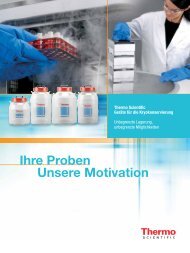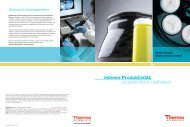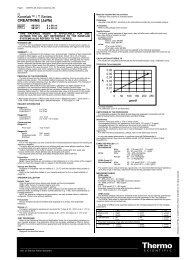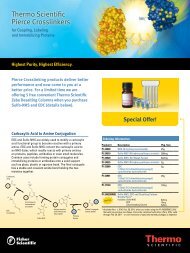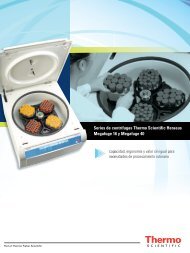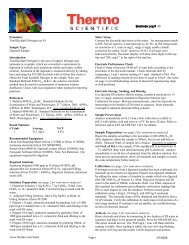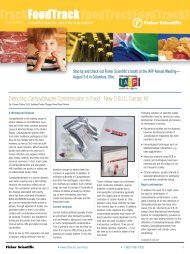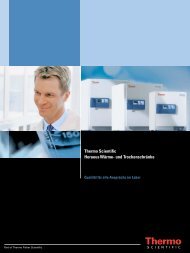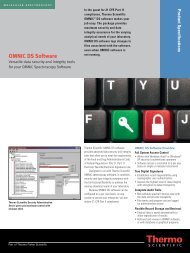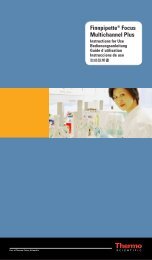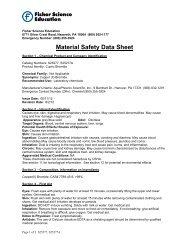Thermo Scientific BioLite Cell Culture Products - Fisher Scientific
Thermo Scientific BioLite Cell Culture Products - Fisher Scientific
Thermo Scientific BioLite Cell Culture Products - Fisher Scientific
You also want an ePaper? Increase the reach of your titles
YUMPU automatically turns print PDFs into web optimized ePapers that Google loves.
Technical Data<br />
<strong>Cell</strong> Growth on <strong>BioLite</strong> <strong>Cell</strong> <strong>Culture</strong> <strong>Products</strong><br />
Introduction<br />
<strong>Cell</strong> culture surfaces in flask, dish and plate formats are<br />
produced by modifying a polymer surface to enhance cell<br />
adhesion. The parameters of modification may vary from<br />
manufacturer to manufacturer, which sometimes results in<br />
cell line adherence differences.<br />
Since performance for any given cell line can vary<br />
between cell culture products from different<br />
manufacturers, it is important to know how your cell line<br />
might perform when using a new product. In this study,<br />
the performance of HEK and VERO cells compares the new<br />
<strong>BioLite</strong> cell culture products to similar products.<br />
Materials and Methods<br />
<strong>Cell</strong> lines<br />
HEK: Human kidney, transferring (ATCC CRL-1573)<br />
VERO: Monkey kidney, (ATCC CCL-81)<br />
Media<br />
• <strong>Thermo</strong> <strong>Scientific</strong> HyClone Media, #SH30024.02;<br />
MEM/EBSS with 2 mM L-glutamine<br />
• Non-Essential Amino acids solution (NEAA) (100 x)<br />
Sodium pyruvate, 100 mM solution<br />
• Antibiotic/Antimycotic solution: Sigma #A9909<br />
(100 ml) Fetal bovine serum (FBS) 10%<br />
<strong>Cell</strong> <strong>Culture</strong> Evaluation<br />
For each flask brand or type, a total of six flasks were<br />
evaluated. Five flasks were used for cell enumeration and<br />
one was stained and imaged. <strong>Cell</strong>s were seeded at the<br />
same density (~30,000 cell/cm 2 and ~10,000 cells/cm 2<br />
for HEK and VERO cells, respectively) and incubated for<br />
three days at 37°C and 5% CO 2 . After three days the cell<br />
yield was carefully determined by harvesting all the cells<br />
with trypsin, and counting the cells using a Nucleocounter<br />
(New Brunswick <strong>Scientific</strong>). The difference in cell count<br />
from the beginning to the end of the experiment was used<br />
to calculate a doubling time for each manufacturer’s<br />
products. The sixth flask was stained with crystal violet<br />
and imaged.<br />
Results are pictured at right. Further analysis is provided<br />
on the next page.<br />
Morphology of HEK <strong>Cell</strong>s (Crystal Violet Stain)<br />
<strong>BioLite</strong> Flask Flask G<br />
Flask CT Flask T<br />
Morphology of VERO <strong>Cell</strong>s (Crystal Violet Stain)<br />
<strong>BioLite</strong> Flask Flask G<br />
Flask CT Flask T



